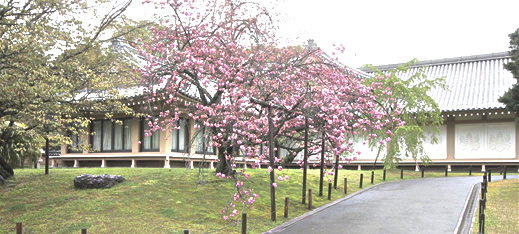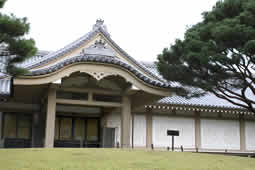Please Enter
Shimo-Daigo
Now you are in front of the Nio Gate which was reconstructed by Toyotomi Hideyori.
At the back of the gate, you see a huge complex of Shimo-Daigo area.
One of the main building in the Shimo-Daigo area is the Golden Hall(Kondo).
The present "Golden-hall" was moved from Yuasa in Kishu (the present Wakayama Prefecture) by the order of Toyotomi Hideyoshi.
You can see a type of architecture in the end of Heian period in its main part.
This hall is dedicated to the Yakushi triad (Tathagata Bhaisajya-guru together with two followers, i.e., Bodhisattvas Nikko and Gakko).
These statues were sculptured in Kamakura period and designated as important cultural assets.
In this area you see a tall building.
it is the Goju-No-To.
Its construction was for the repose of the Emperor Daigo and completed in 951 at the reign of the Emperor Murakami.
This is the oldest building in Kyoto.
Inside of the pagoda, moreover,
there are the paintings which provide invaluable information about the origin of arts in Japnese esoteric Buddhism.
In the Shimo-Daigo area, furthermore, there are Seiryugu Main Hall (Honden),
Soshi-hall (The Hall dedicated to Rigen-daishi), Fudo hall, Dai kodo, Nyonin Hall, and Benten Hall.
In Daigo temple, both area of Daigo altogether there are 6 buildings of national treasures and 10 buildings of important cultural assets.
These buildings have watched a long history of Daigoji.
In front of them you can make yourself feel at ease.
Please Enter Shimo-daigo area.
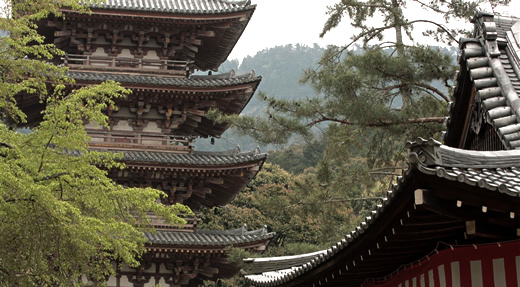
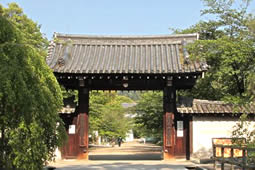
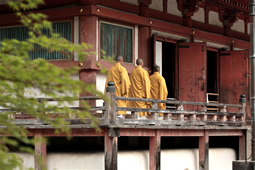
Saidaimon(Niomon)
It was rebuilt in 1605 when Toyotomi Hideyori restorated the Golden Hall (Kondo). The Nio statues were sculptured by Buddhist statue creators Seizo and Ninzo in 1134, in the end of Heian period, and originally located in Nandaimon. Some documents installed inside the statue inform us the removal from Nandaimon.
Seiryugu Honden Muromachi Period (important cultural asset) / Seiryugu Haiden
This tutelary shrine is dedicated to the local deity of Daigoji, Seiryu Gongen. The first tutelary shrine was built in Kami-Daigo and then another one was built here. Later, Seiryu-e (also known as "Sakura-e") began to be held in front of this building. But it was burnt down. The present building was built in 1517. Also, the Oratory was rebuilt by Gien, the rural dean of Daigoji, in 1599. This is the center of various events for the Seiryu-Gongen-Sakura-e held between April 1 and 21 every year.
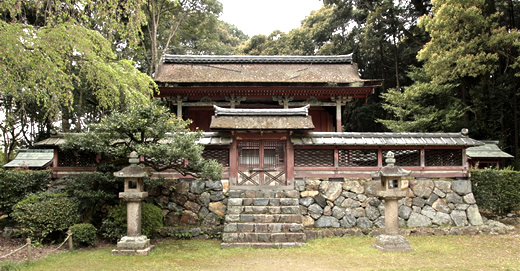

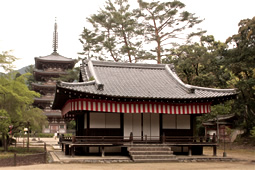
Kondo (national treasure)
Kondo was built in 926 upon the request of Emperor Daigo. The hall, which was called Shakado in those days, was burned down twice in the Einin and Bunmei periods. The present Kondo was relocated from Yuasa in Kishu (Wakayama prefecture), which was planned by order of Toyotomi Hideyoshi and completed by Toyotomi Hideyori in 1600. This is the central hall in the Daigoji complex, and the seated statue of Yakushinyorai (Bhaisajyaguru,the Healing Buddha) enshrined there is the principal image of Daigoji Temple.
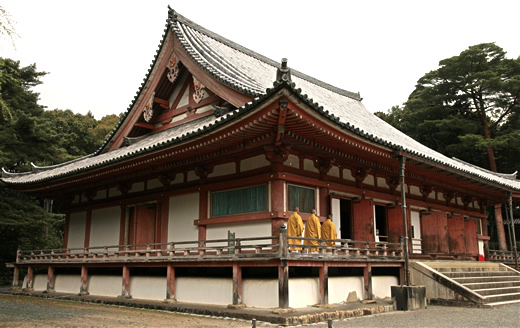
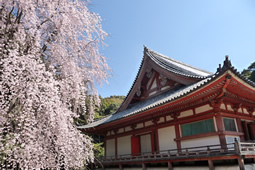
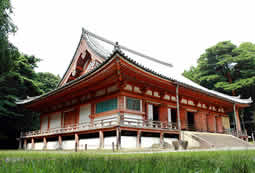
Inside of KondoYakushi triad (important cultural assets)
In the center of Kondo Yakushi triad (Yakushi Nyorai together with Nikko and Gakko bodhisattvas) is enshrined. These excellent works composed in the early Kamakura period are the imitations of Danzo sculptures in the early Heian period. The four statues on both sides of the triad are of Shiten'no, the deities of world guardians to protect the four directions.
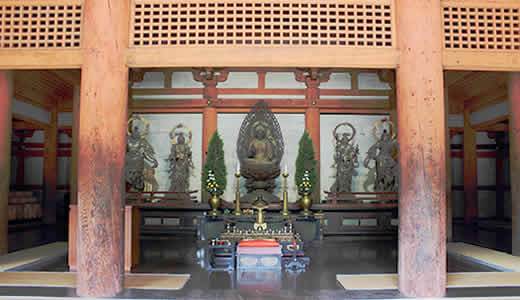
Goju-no-to (five-storey pagoda, a national treasure)
Emperor Suzaku, the oldest son of Emperor Daigo, started the construction of the pagoda in 936 for the repose of Emperor Daigo's soul and the pagoda was completed in 951 during the reign of Emperor Murakami, the second son of Emperor Daigo. Ryokai-mandala (Mandala of the Two Realms) and Shingon-hasso (Eight Patriarchs of the Shingon mission) are painted in the first story of the pagoda, which provide invaluable information about the origin of arts in Japnese esoteric Buddhism. The pagoda is about 38 meters tall, including the approx. 13-meter sorin (pagoda finial) on the top of the roof. The sorin accounts for one-third of the pagoda's height, giving a sense of stability.

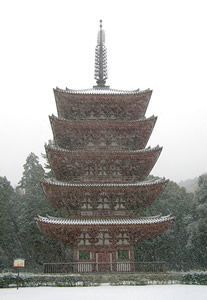

Wall-painting on the ground floor of the Goju-No-To
The wall painting in the ground floor is designated to the National Treasure as well as the building of the Goju-No-To. This wall painting is considered as the origin of the art history of the Japanese Esoteric Buddhism, for the various deities in the two sorts of mandala, i.e., the Diamoind or Thunderbolt Realm (kongokai) and the Matrix or Womb Realm(taizokai), and the founders of Shingon schools are dipicted completely. This is the only one that the date of compostion is certain among those in the 10th century. Moreover, it is highly evaluated as the excellent work. Especially the figure of Kukai is the oldest among the extant drawings and paintings.
Fudodo, Goma-dojo
Five statues of Myo-o (Vidyaraja), with Fudo Myo-o (Acalanatha) in the center, are enshrined in Fudodo Hall. At Goma-dojo in front of Fudodo, the Saitogoma ceremony is performed by Tozan-ha mission practitioners of Shugen-do to pray for various concerns including world peace.
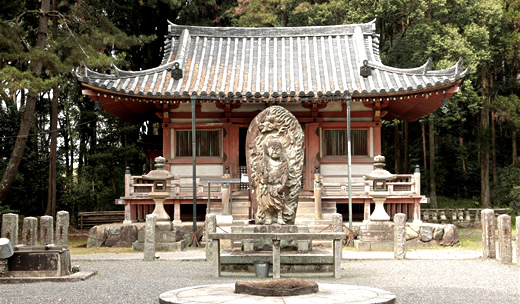
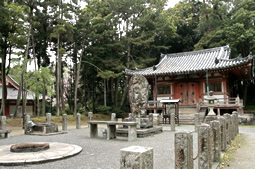
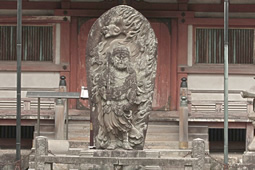
Shinnyo Sanmayado
This hall was originally built as the Hokke Sanmayado Hall in 949 upon request of Emperor Suzaku, but it was burned down in 1470. The present hall was built as Shinnyo Sanmayado in 1997.
Soshido
In 1605 this building was constructed by the head of Daigoji temple, Gien. It is dedicated to Kobo Daishi and Rigen Daishi. Kobo Daishi Kukai, who established the Shingon mission, and his grand pupil Rigen Daishi Shobo, who founded Daigoji Temple, are enshrined in this hall. A grand ceremony is held on June 15, Kobo Daishi's birthday.
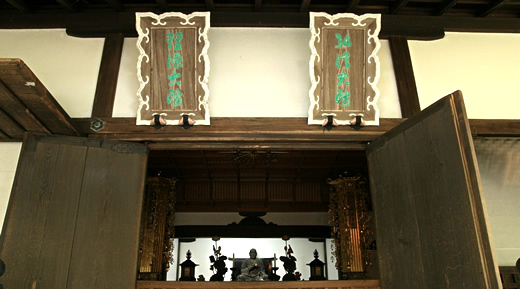
Daikodo
The View of Denpoin Daikodo from Rinsen, Bentendo-hall, Jizodo-hall, Bell, Denpogakuin, and so on, which are located around Daikodo, are called Daidenpoin. These halls were constructed as monumentalization of the millennial aniversary of the Emperor Daigo's death donated by Yamaguti Gendo-koji in 1930. Architecture type is called Hogyo-zukuri, which has the stone base. The Denpogakuin is a practice hall for Buddhist monks. Daigoji Temple's largest wooden seated statue of Amidanyorai (Amitabha), approximately 240-cm (8 feet) tall, created in the late Heian period, is enshrined in Daikodo Hall. A seated statue of Dainichinyorai (Mahavairocana), as well as statues of Jinja-taisyo, Daikokuten (Mahakala) and Jizobosatsu (Ksitigarbha bodhisattva), is also enshrined.
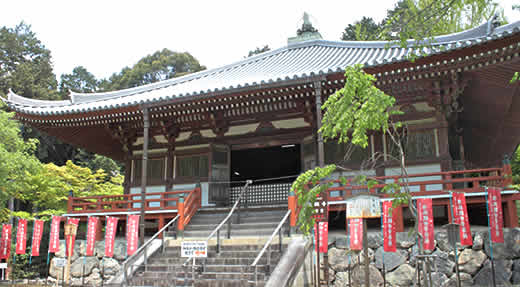
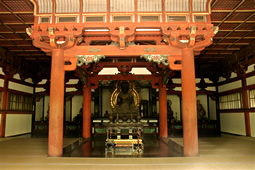

Bentendo
The Bentendo Hall is famous for the beautiful colored leaves in the fall when maples and ginkgos turn red and yellow. The combination of the vermilion-lacquered hall and the pond in front completes the beautiful scenery. Bentendo is dedicated to Benzaiten (Sarasvati), the goddess of knowledge and liberal arts such as music and is generally known as one of Seven Deities of Good Fortune (Shichifukujin).
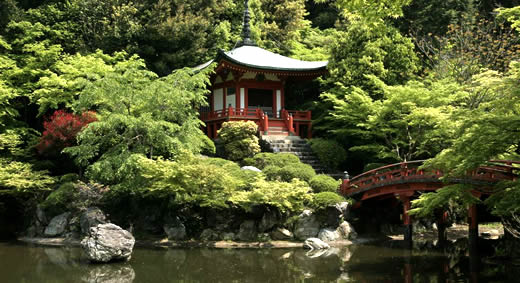

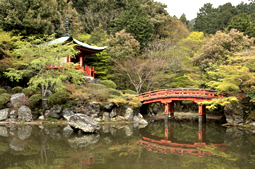
Joshinin (Nyonindo)
Joshinin is located at the starting point for the climb to Kami-Daigo. It is commonly known as "Nyonindo," since the women worshipped the buddhas on the mountain form this very spot a long time ago. The present hondo (main hall) is said to have been reconstructed in the early Edo period. Another Juntei Kannon, which is dedicated at the top of the mountain, is enshrined as the principal image of Joshinin. Fudo Myo-o, Shobo Rigen Daishi, Mirokubosatsu (Maitreya bodhisattva), Enno Gyoja and Jizobosatsu statues are enshrined in front of the main hall, in the order from the top to the base of the mountain.
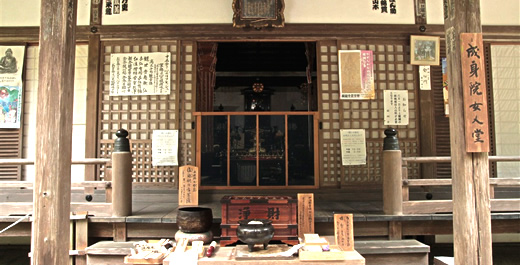


Houonin
Kenjin, the 35th archbishop of Daigoji Temple, used Gokurakubo in Kami-Daigo as his base for activities and renamed it"Houonin." Later, it was relocated to Shimo-Daigo by order of the retired emperor Go-Uda, and then relocated to the present site in the Meiji era. Goma (the ceremony of a holy fire) is lit from 13:00 everyday to pray to Fudo Myo-o, the principal image, for family welfare, success in business, the removal of bad luck, the invitation of good luck etc. In addition, prayers for car traffic safety are also performed in front of the hall.

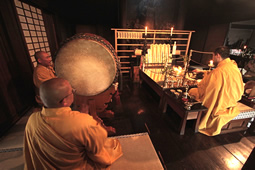
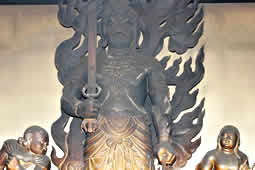
Reihokan (Museum)
As many as approximately one hundred thousand treasures of the Daigoji complex, including forty thousand national treasures and important cultural assets, as well as non-designated cultural assets, are preserved in the Reihokan. Preserved assets include carvings, paintings, craftworks, and ancient documents that are valuable materials in the history of Buddhism in Japan, Japanese history and also art history. Some of them are exhibited to the public in spring and fall.
